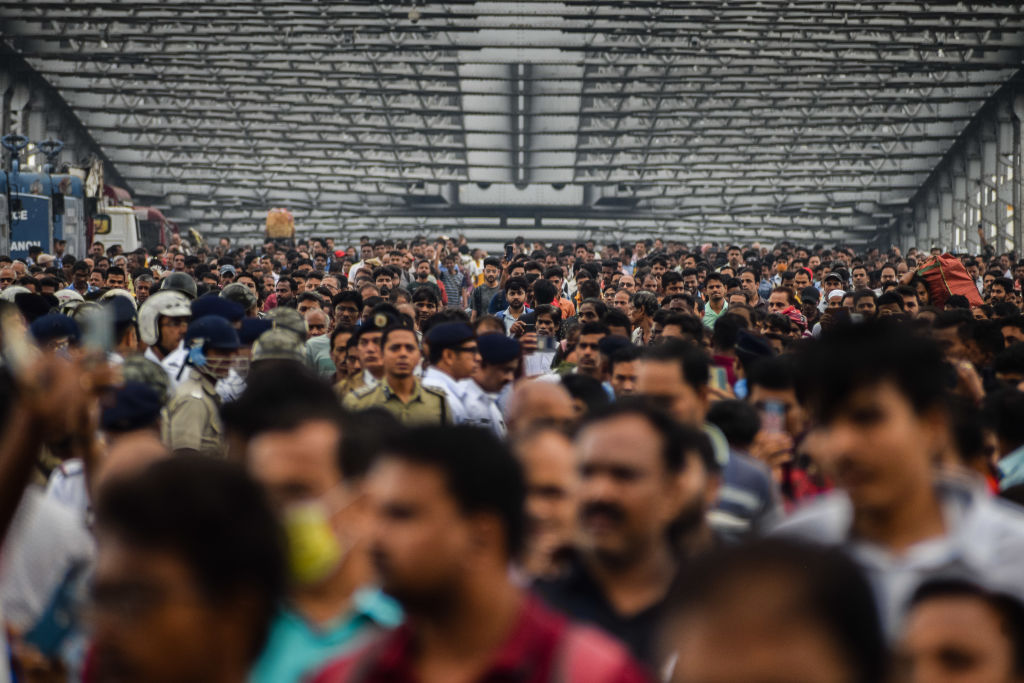风萧萧_Frank
以文会友印度为何无法像中国一样成为经济超级大国
https://www.aspistrategist.org.au/why-india-unlike-china-wont-be-an-economic-superpower/
Ashoka Mody 2023年8月1日
1985年3月,《华尔街日报》对印度新任总理拉吉夫·甘地给予了极高的评价。在一篇题为“拉吉夫·里根”的社论中,该报将40岁的甘地比作“我们熟知的另一位著名的减税者”,并宣称放松管制和减税政策在印度引发了一场“小革命”。
三个月后,在甘地访美前夕,哥伦比亚大学经济学家贾格迪什·巴格瓦蒂的评价更加热情洋溢。他在《纽约时报》上撰文称:“如今的印度远胜于中国,是一个即将发生的经济奇迹。” “如果奇迹真的发生,核心人物将是这位年轻的总理。”巴格瓦蒂还赞扬了甘地执政期间的减税和放松监管政策。
20世纪80年代初是一个关键的历史时刻,中国和印度——这两个世界上人口最多的国家,人均收入几乎相同——开始自由化和开放经济。两国都引发了人们对“革命”和“奇迹”的预测。然而,中国在强大的人力资本发展基础上实现了快速增长,而印度在这方面却有所欠缺。中国成为了经济超级大国;预测印度将成为下一个超级大国不过是炒作而已。
这种差异由来已久。1981年,世界银行将中国“极高的”预期寿命64岁与印度的51岁进行了对比。报告指出,中国公民的饮食状况比印度公民更好。此外,中国几乎实现了全民医疗保健,其公民(包括女性)享有更高的初等教育接受率。
世界银行的报告强调了毛泽东时代中国在性别平等方面取得的显著进步。正如纪思道和吴敦义在其2009年出版的《半边天》一书中所指出的,中国(尤其是城市地区)成为“女性成长的最佳场所之一”。受教育机会的增加和女性劳动力参与率的提高导致了生育率的下降和育儿方式的改善。世界银行认可中国在发展人力资本和增强妇女权能方面取得的进步,并做出了一个异常大胆的预测:中国将在“大约一代人的时间内”实现生活水平的“大幅提高”。
世界银行的报告没有关注减税或经济自由化,而是关注布朗大学经济学家奥德·加洛尔最近强调的一个历史事实。自工业革命以来,每一次经济进步——其关键在于持续的生产力增长——都与人力资本投资和女性劳动力参与率的提高息息相关。
诚然,市场自由化极大地促进了中国和印度的经济增长。但中国的成功发展战略建立在人力资本和性别平等这两大支柱之上,而印度在这些领域远远落后。
即使在更加市场化之后,中国仍在人力资本方面进行了令人印象深刻的投资,在将教育和健康标准提高到拥有国际竞争力的劳动力所需的水平方面,中国的表现超过了印度。世界银行2020年人力资本指数(以0到1的等级衡量各国的教育和健康成果)显示,印度的得分为0.49,低于尼泊尔和肯尼亚这两个较为贫穷的国家。中国的得分为0.65,与人均收入更高、更富裕的智利和斯洛伐克相当。
中国女性劳动力参与率已从1990年的约80%下降至约62%,而印度同期女性劳动力参与率则从32%下降至约25%。尤其是在城镇地区,针对女性的暴力行为阻碍了印度女性进入劳动力市场。
优越的人力资本和更高的性别平等水平共同推动了中国全要素生产率的大幅增长,而全要素生产率是衡量资源利用效率的最全面指标。假设两国经济体在1953年(大约在它们开始现代化进程之时)的生产率相同,那么到20世纪80年代末,中国的生产率已比印度高出50%以上。如今,中国的生产力几乎是印度的两倍。尽管45%的印度工人仍在生产率极低的农业部门工作,但中国甚至已经从简单的劳动密集型制造业转型,成为全球汽车市场(尤其是在电动汽车领域)的主导力量。
中国也为迎接未来机遇做好了更充分的准备。中国有七所大学跻身世界百强,其中清华大学和北大大学跻身前二十。清华大学被认为是世界领先的计算机科学大学,而北大则排名第九。同样,中国有九所大学跻身全球数学学科前五十。相比之下,包括著名的印度理工学院在内的印度大学均未跻身世界百强。
中国科学家在提升研究数量和质量方面取得了显著进展,尤其是在化学、工程和材料科学等领域,并可能很快在人工智能领域占据领先地位。
自20世纪80年代中期以来,印度和其他国际观察家就预测,专制的中国兔子最终会衰落,而民主的印度乌龟将赢得比赛。最近发生的事件——中国严格的“零新冠”限制、不断上升的青年失业率,以及中国当局为控制国内过度扩张的房地产行业和大型科技公司而采取的笨拙措施所带来的负面影响——似乎证实了这种观点。
然而,尽管中国凭借雄厚的人力资本和更高的性别平等水平,站在新旧经济的前沿,但印度领导人及其国际同行却吹嘘自己拥有一种超越历史的能力,能够凭借光鲜的数字和物理基础设施跨越脆弱的人力基础。中国在当前的困境中拥有一条可行的道路。相比之下,印度则面临陷入盲目乐观的死胡同的风险。
作者
阿育王·莫迪,普林斯顿大学国际经济政策客座教授,曾在世界银行和国际货币基金组织工作。他著有《印度支离破碎:一个被背叛的民族,从独立到今天》。本文由 Project Syndicate 联合呈现
《破碎的印度:一个被背叛的民族,从独立至今》
https://www.amazon.ca/India-Broken-People-Betrayed-Independence/dp/1503630056
作者:阿育王·莫迪 (Ashoka Mody),2023年2月14日
这部引人入胜的新作讲述了印度如何从1947年充满希望的建国之初,一路走到如今经济和民主的戏剧性崩溃。
1947年,印度领导人首次执掌政府时,便宣扬了民族团结和世俗民主的理想。在建国后的前半个世纪里,领导人在关键目标上取得了不均衡但可衡量的进展。20世纪80年代中期之后,赤贫状况在几十年间有所下降,鼓舞人心地宣告胜利。但如今,绝大多数印度人生活在就业不足的困境中,距离绝望只有一步之遥。公共产品——医疗卫生、教育、城市建设、空气和水资源以及司法系统——状况堪忧。只要这种情况持续下去,优质就业岗位就将持续稀缺。就业岗位的匮乏将进一步削弱民主,进而进一步削弱就业创造。《支离破碎的印度》一书对这一经济困境提供了最具说服力的阐释。
莫迪挑战了主流观点,认为从首任总理贾瓦哈拉尔·尼赫鲁开始,历届独立后的领导人都未能直面印度真正的经济问题,而是寻求简单的解决方案。随着民众的不满情绪日益加深,政治腐败日益猖獗,印度的经济增长越来越依赖于不受监管的金融和破坏环境的建设。暴力印度教民族主义的兴起,彻底摧毁了公民生活和公共问责方面的所有先前规范。
本书将统计数据与文学、电影等创意媒介相结合,创造出强有力的、通俗易懂的、以人为本的叙事,是对民主与经济进步之间相互作用的反思,其经验教训远不止印度。莫迪提出了一条充满危险的前进之路,但它却带来了一丝希望。
Why India, unlike China, won’t be an economic superpower
https://www.aspistrategist.org.au/why-india-unlike-china-wont-be-an-economic-superpower/
Ashoka Mody 1 Aug 2023

In March 1985, the Wall Street Journal showered India’s new prime minister, Rajiv Gandhi, with its highest praise. In an editorial titled ‘Rajiv Reagan’, the newspaper compared the 40-year-old Gandhi to ‘another famous tax cutter we know’, and declared that deregulation and tax cuts had triggered a ‘minor revolution’ in India.
Three months later, on the eve of Gandhi’s visit to the United States, Columbia University economist Jagdish Bhagwati was even more effusive. ‘Far more than China today, India is an economic miracle waiting to happen,’ he wrote in the New York Times. ‘And if the miracle is accomplished, the central figure will be the young prime minister.’ Bhagwati also praised the reduced tax rates and regulatory easing under Gandhi.
The early 1980s marked a pivotal historical moment, as China and India—the world’s most populous countries, with virtually identical per capita incomes—began liberalising and opening up their economies. Both countries elicited projections of ‘revolution’ and ‘miracle’. But while China grew rapidly on a strong foundation of human-capital development, India shortchanged that aspect of its growth. China became an economic superpower; projections of India as next are little more than hype.
The differences have been long in the making. In 1981, the World Bank contrasted China’s ‘outstandingly high’ life expectancy of 64 years to India’s 51 years. Chinese citizens, it noted, were better fed than their Indian counterparts. Moreover, China provided nearly universal health care, and its citizens—including women—enjoyed higher rates of primary education.
The World Bank report highlighted China’s remarkable strides towards gender equality during the Mao Zedong era. As Nicholas Kristof and Sheryl WuDunn note in their 2009 book Half the sky, China (particularly its urban areas) became ‘one of the best places to grow up female’. Increased access to education and the higher female labour-force participation rate resulted in lower birth rates and improved child-rearing practices. Recognising China’s progress in developing human capital and empowering women, the World Bank made an unusually bold prediction: China would achieve a ‘tremendous increase’ in living standards ‘within a generation or so’.
Rather than tax cuts or economic liberalisation, the World Bank report focused on a historical fact recently emphasised by Brown University economist Oded Galor. Since the dawn of the Industrial Revolution, every instance of economic progress—the crux of which is sustained productivity growth—has been associated with investments in human capital and higher female workforce participation.
To be sure, market liberalisation greatly helped Chinese and Indian growth. But China built its successful development strategy on the twin pillars of human capital and gender equality, areas in which India has lagged far behind.
Even after it became more market-oriented, China invested impressively in its people, outpacing India in raising education and health standards to levels necessary for an internationally competitive workforce. The World Bank’s 2020 Human Capital Index—which measures countries’ education and health outcomes on a scale of 0 to 1—gave India a score of 0.49, below Nepal and Kenya, both poorer countries. China scored 0.65, similar to the much richer (in per capita terms) Chile and Slovakia.
While China’s female labour-force participation rate has decreased to roughly 62% from around 80% in 1990, India’s has fallen over the same period from 32% to around 25%. Especially in urban areas, violence against women has deterred Indian women from entering the workforce.
Together, superior human capital and greater gender equality have enabled much higher Chinese total factor productivity growth, the most comprehensive measure of resource-use efficiency. Assuming that the two economies were equally productive in 1953 (roughly when they embarked on their modernisation efforts), China became over 50% more productive by the late 1980s. Today, China’s productivity is nearly double that of India. While 45% of Indian workers are still in the highly unproductive agriculture sector, China has graduated even from simple, labour-intensive manufacturing to emerge, for example, as a dominant force in global car markets, especially in electric vehicles.
China is also better prepared for future opportunities. Seven Chinese universities are ranked among the world’s top 100, with Tsinghua and Peking among the top 20. Tsinghua is considered the world’s leading university for computer science, while Peking is ranked ninth. Likewise, nine Chinese universities are among the top 50 globally in mathematics. By contrast, no Indian university, including the celebrated Indian Institutes of Technology, is ranked among the world’s top 100.
Chinese scientists have made significant strides in boosting the quantity and quality of their research, particularly in fields such as chemistry, engineering and materials science, and could soon take the lead in artificial intelligence.
Since the mid-1980s, Indian and other international observers have predicted that the authoritarian Chinese hare would eventually falter and the democratic Indian tortoise would win the race. Recent events—China’s harsh zero-Covid restrictions, rising youth unemployment and the adverse repercussions of the Chinese authorities’ ham-handed efforts to rein in the country’s overgrown real-estate sector and large tech companies—seem to support this view.
But while China, with its deep well of human capital and greater gender equality, stands poised at the frontiers of both the old and the new economies, Indian leaders and their international counterparts tout an ahistorical ability to leapfrog over a fragile human foundation with shiny digital and physical infrastructure. China has a plausible path through its current muddle. India, by contrast, risks falling into blind alleys of unfounded optimism.
Ashoka Mody, visiting professor of international economic policy at Princeton University, previously worked for the World Bank and the International Monetary Fund. He is the author of India is broken: a people betrayed, independence to today. This article is presented in partnership with Project Syndicate © 2023. Image: Sankhadeep Banerjee/NurPhoto via Getty Images.
India Is Broken: A People Betrayed, Independence to Today
https://www.amazon.ca/India-Broken-People-Betrayed-Independence/dp/1503630056
by Ashoka Mody (Author) Feb. 14 2023
A provocative new account of how India moved relentlessly from its hope-filled founding in 1947 to the dramatic economic and democratic breakdowns of today.
When Indian leaders first took control of their government in 1947, they proclaimed the ideals of national unity and secular democracy. Through the first half century of nation-building, leaders could point to uneven but measurable progress on key goals, and after the mid-1980s, dire poverty declined for a few decades, inspiring declarations of victory. But today, a vast majority of Indians live in a state of underemployment and are one crisis away from despair. Public goods―health, education, cities, air and water, and the judiciary―are in woeful condition. And good jobs will remain scarce as long as that is the case. The lack of jobs will further undermine democracy, which will further undermine job creation. India is Broken provides the most persuasive account available of this economic catch-22.
Challenging prevailing narratives, Mody contends that successive post-independence leaders, starting with its first Prime Minister, Jawaharlal Nehru, failed to confront India's true economic problems, seeking easy solutions instead. As a popular frustration grew, and corruption in politics became pervasive, India's economic growth relied increasingly on unregulated finance and environmentally destructive construction. The rise of a violent Hindutva has buried all prior norms in civic life and public accountability.
Combining statistical data with creative media, such as literature and cinema, to create strong, accessible, people-driven narratives, this book is a meditation on the interplay between democracy and economic progress, with lessons extending far beyond India. Mody proposes a path forward that is fraught with its own peril, but which nevertheless offers something resembling hope.




